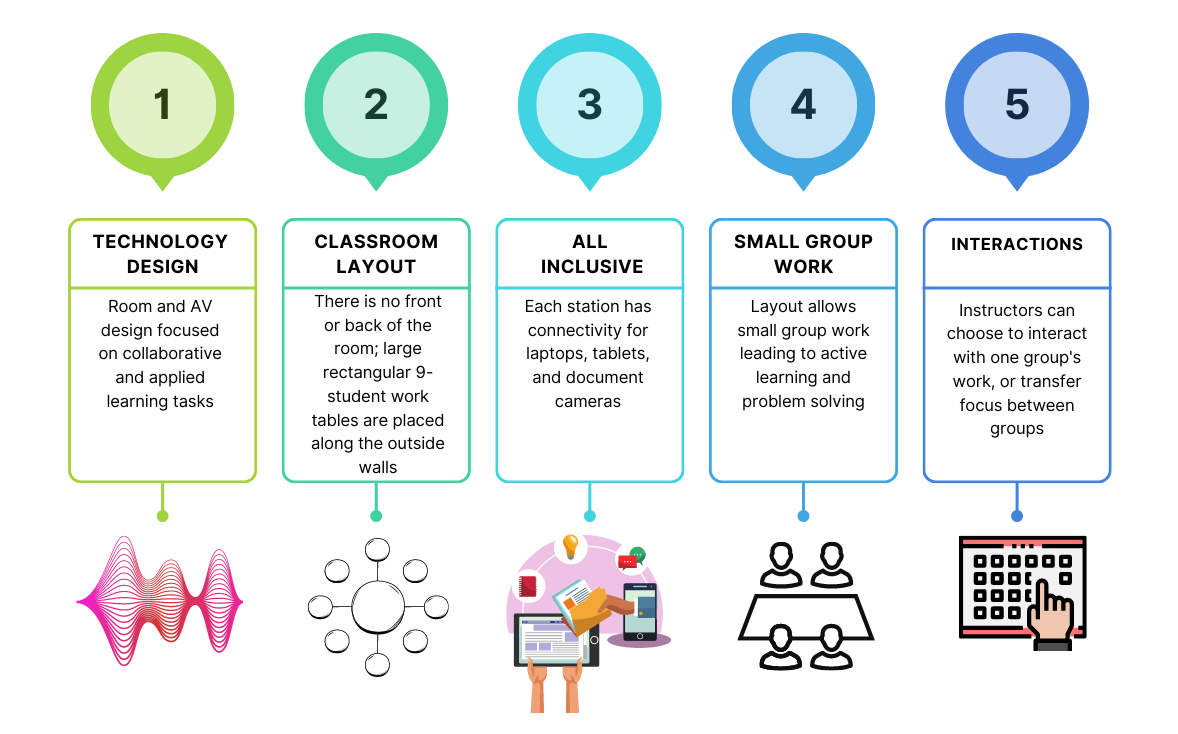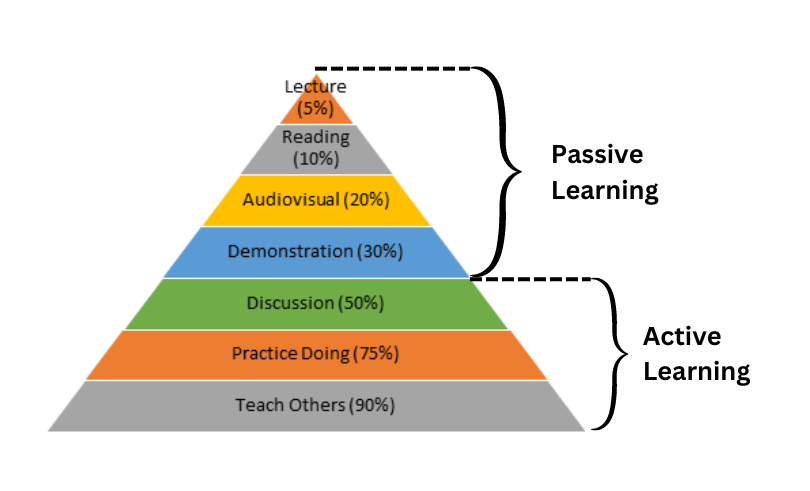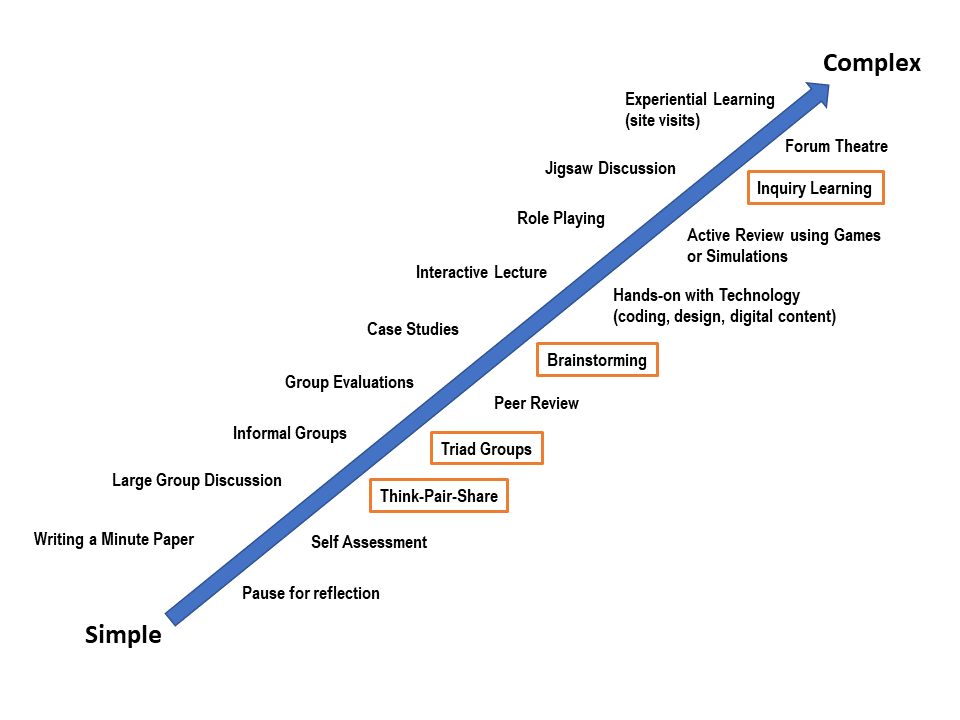“Learning is not a spectator sport.”
Chickering and Gamson, 1987
Teaching Commons Instructional Designers are available to assist Instructors in all aspects of utlizing TEAL spaces on campus. Request a Consultation
Technology Enabled Active Learning (TEAL) instructional spaces are designed to engage students and promote active learning, encouraging students to think deeply about the things they are doing (Barkley, 2010). According to organizations like the Association of American Universities (AAU) and the American Association of Colleges and Universities (AACU), which support high-impact strategies promoting student engagement and deep learning, the rise in active learning instructional spaces such as TEAL are excellent.
So why does active learning matter and how does a TEAL instructional space support this?
Active learning helps promote higher order thinking skills such as application of knowledge, analysis and synthesis. It engages students in deep rather than surface level learning, and enables them to apply and transfer knowledge better.
TEAL spaces aim to provide more opportunities for innovative use of creativity and comprehensive peer-to-peer and instructor interaction which helps to increase student motivation, promote collaboration and enabling access to knowledge and skills for all.
A recent study indicated that active learning narrows achievement gaps for underrepresented students in undergraduate Science, Technology, Engineering, and Math (STEM). This study collected data on exam scores and failure rates in a range of STEM courses that had been taught by the same instructor via both traditional lecturing and active learning. The results revealed that on average, active learning reduced achievement gaps in exam scores and passing rates. Active learning benefited all students but offered disproportionate benefits for individuals from underrepresented groups (Theobald, 2020).
Why has UC Merced added TEAL Labs?
As one of the newest higher education institutions in California, UC Merced supports innovative teaching methods like access to 4 TEAL labs for teaching: two 35-seat rooms and two 90-seat rooms. These Technology Enhanced Active Learning (TEAL) are physical instructional spaces that infuse technology with active learning.

Technology Enhanced Active Learning: Enabling Learning Beyond Traditional Boundaries
TEAL Active Learning Strategies
Classroom + Active Learning + Technology
How is a TEAL space different?
Technologies include active learning group tables, each with a display and functionality for students to share their ideas in their groups. This active-learning pedagogy supports group work, facilitated discussions, simulations, coding demonstrations and hands-on experiments to support student learning outcomes. Additionally, Students can connect their own laptops or tablets to the displays or use the visual presenter (doc cam) provided at each table. The technology in the spaces givers instructors the flexibility to direct students to work in groups, direct student attention to what the instructor is sharing, or direct student attention to what another group is sharing.
Active Learning vs. Traditional Classroom Learning
What is Active Learning?
Using the Learning principles, Dale’s Cone of Experience (figure 1, below) shows the passive and active parts of learning. Passive learning includes using methods such as lectures, reading, audiovisual, and demonstration to retain information. Active learning includes using participatory learning and teaching methods such as making the content relevant to the audience, having group discussions, and having participants practice by doing and showing/ teaching others how to retain information.
Figure 1: Dale's Cone of Experience

Research indicates that varying learning methods improve retention and recall of information. Dale’s Cone of Experience developed by the National Training Laboratory, suggests that learners remember about 10% of what they read from textbooks, but retain nearly 90% of what they learn through actively engaging with it through group discussions, practice by doing, or teaching others. This method also suggests that some methods of study are more effective than others and that varying learning methods lead to deeper learning and long-term retention.
TEAL instructional spaces blend technology with active pedagogy with the following benefits:
- Technology Design: Room and AV design focused on collaborative and applied learning tasks
- Classroom Layout: There is no front or back of the room; large rectangular 9-student work tables are placed along the outside of walls
- All-Inclusive: Each station has connectivity for laptops, tablets, and document cameras
- Small Group Work: Layout allows small group work leading to active learning and problem solving
- Interactions: Instructors can choose to interact with one group’s work, or transfer focus between groups
Active Learning Activities in a TEAL Space
There are many active learning strategies available to enhance student engagement. These can vary on a spectrum from simple to complex as defined below in figure 2. This diagram shows many strategies, labeled from Simple to Complex. We have highlighted a few activities and describe in the next section, how they might be implemented. Active Learning Activity Descriptions
Figure 2: Active Learning Activities from Simple to Complex.

Adapted from Chris O’Neal and Tershia Pinder-Grover, Center for Research on Learning and Teaching, University of Michigan.
Examples of Active Learning Activities in a TEAL Space
Table 1 (below) contains examples of active learning strategies that can be implemented in a TEAL space utilizing the room technology. Activities can range from simple to complex as described above in Figure 2 and there are a variety of options that can be used depending on the preparation and delivery time required for a class.
Table 1: Sample Learning Activties for TEAL Spaces
| Active Learning Strategy | Description | Technology Integration Ideas |
|---|---|---|
| Think-Pair-Share |
Students use the collaborative learning approach known as think-pair-share (TPS) to work together to solve a problem or respond to a question regarding the given content. Students must (1) think independently about a subject or respond to a question; and (2) share ideas with classmates as part of this method. Partner discussions increase engagement, concentrate attention, and get students interested in understanding the content. This enhances collaborative learning opportunities that provide students with an opportunity to look at the problem from multiple perspectives while they evaluate their own learning and peers’ learning process. |
|
| Triad Groups | Triad groups use active learning methods in which student is assigned specific role and responsibilities. The roles may rotate and vary over a period of time. Usually, the assigned roles are note-taker, writer, moderator and presenter. |
*The layout and technology available in TEAL allows collaboration and streamlining information with peers and instructors able to access the discussion points. Also, this method allows peers to access group discussion notes at a later point and learn from it. |
| Brainstorming | Brainstorming is a cooperative learning strategy that enables students to generate ideas on a certain topic, or category while the facilitator records the answers using different methods. This encourages students to draw upon their prior knowledge and experiences. |
|
| Inquiry Learning | Inquiry-based learning is a learning process that engages students by making real-world connections through exploration and high-level questioning. This interaction encourages students to engage in problem-solving and helps them in “how to think” instead of “what to think”. |
Instructors can use the 5E inquiry model which includes: 1) Engage, 2) Explore, 3) Explain, 4) Elaborate, 5) Evaluate.
|
References
Adapted in part from these sources:
- Barkley, E.F. (2020). Student Engagement Techniques: A handbook for college professors. San Francisco, CA: Jossey-Bass.
- Chickering, A. W., & Gamson, Z. F. (1987). Seven Principles for Good Practice in Undergraduate Education. The Wingspread Journal, 9, 1-10.
- Kevin Yee (2017). 226 Active Learning Techniques. Center for Excellence in Learning and Teaching, Iowa State University. Creative Commons BY-NC-SA Retrieved from https://www.celt.iastate.edu/wp-content/uploads/2017/03/CELT226activelearningtechniques.pdf
- McGreevy, K.M.; Church, F.C. (2020). Active Learning: Subtypes, Intra-Exam Comparison, and Student Survey in an Undergraduate Biology Course. Educ. Sci. 10, 185.
- O'Neal, C., & Pinder-Grover, T. (n.d.). How can you incorporate active learning into your classroom? Center for Research on Learning and Teaching, University of Michigan. https://crlt.umich.edu/sites/default/files/Active_Learning_Continuum_CRL...
- Theobald, E. J., Hill, M. J., Tran, E., Agrawal, S., Arroyo, E. N., Behling, S., Chambwe, N., Cintrón, D. L., Cooper, J. D., Dunster, G., Grummer, J. A., Hennessey, K., Hsiao, J., Iranon, N., Jones, L., Jordt, H., Keller, M., Lacey, M. E., Littlefield, C. E., … Freeman, S. (2020). Active learning narrows achievement gaps for underrepresented students in undergraduate science, technology, engineering, and math. Proceedings of the National Academy of Sciences. https://doi.org/10.1073/pnas.1916903117
Additional Resources
- Using TEAL Classrooms for Problem Solving from Yale's Poorvu Center for Teaching and Learning
- Teaching Commons Instructional Designers are available to assist Instructors in all aspects of utlizing TEAL spaces on campus. Request a Consultation
- Kevin Yee (2017). 226 Active Learning Techniques. Center for Excellence in Learning and Teaching, Iowa State University. Creative Commons BY-NC-SA
- Designing the New Normal: Enable, Egage, Elevate and Extend Student Learning from Educause Review (https://www.educause.edu/)



